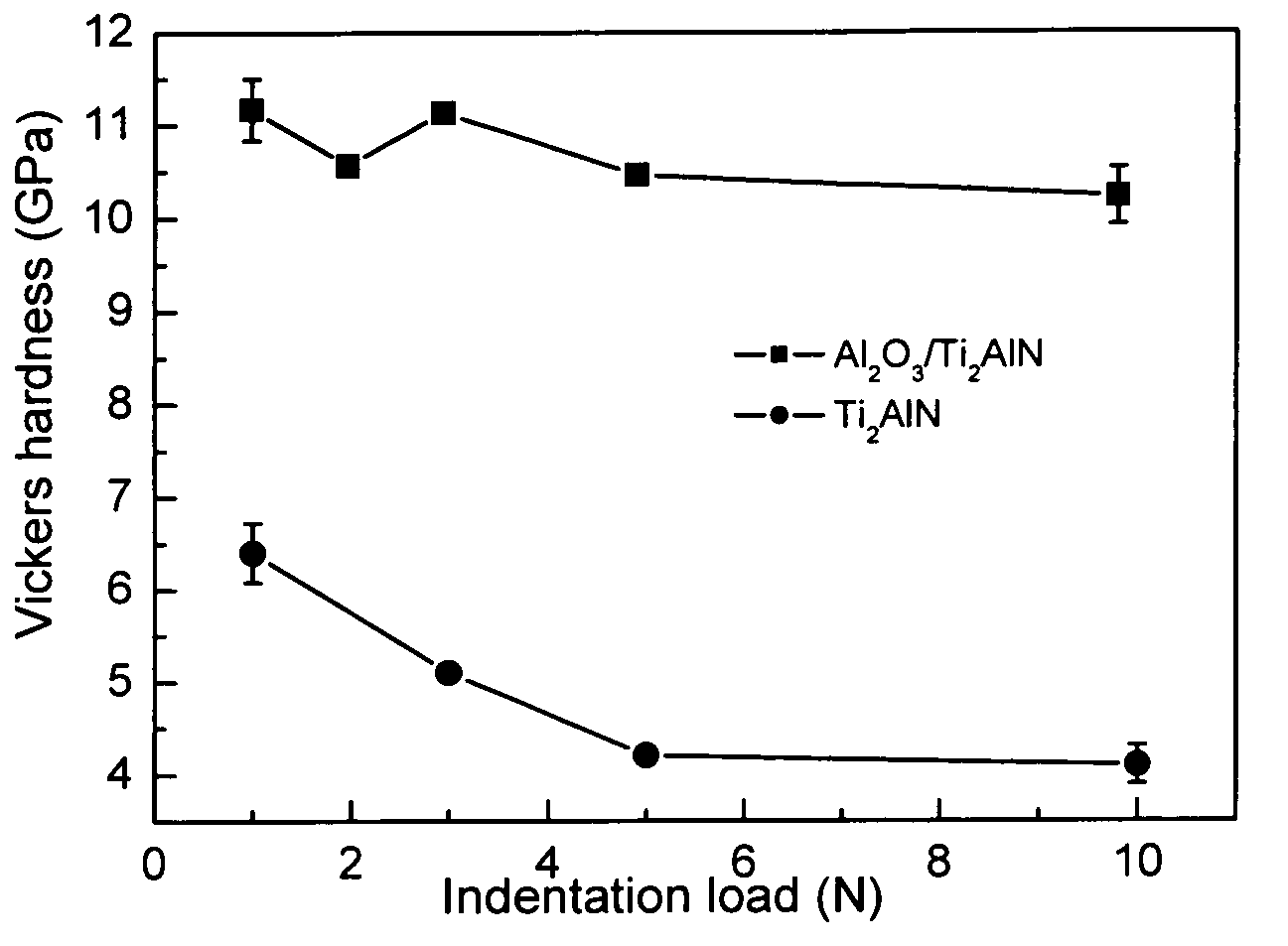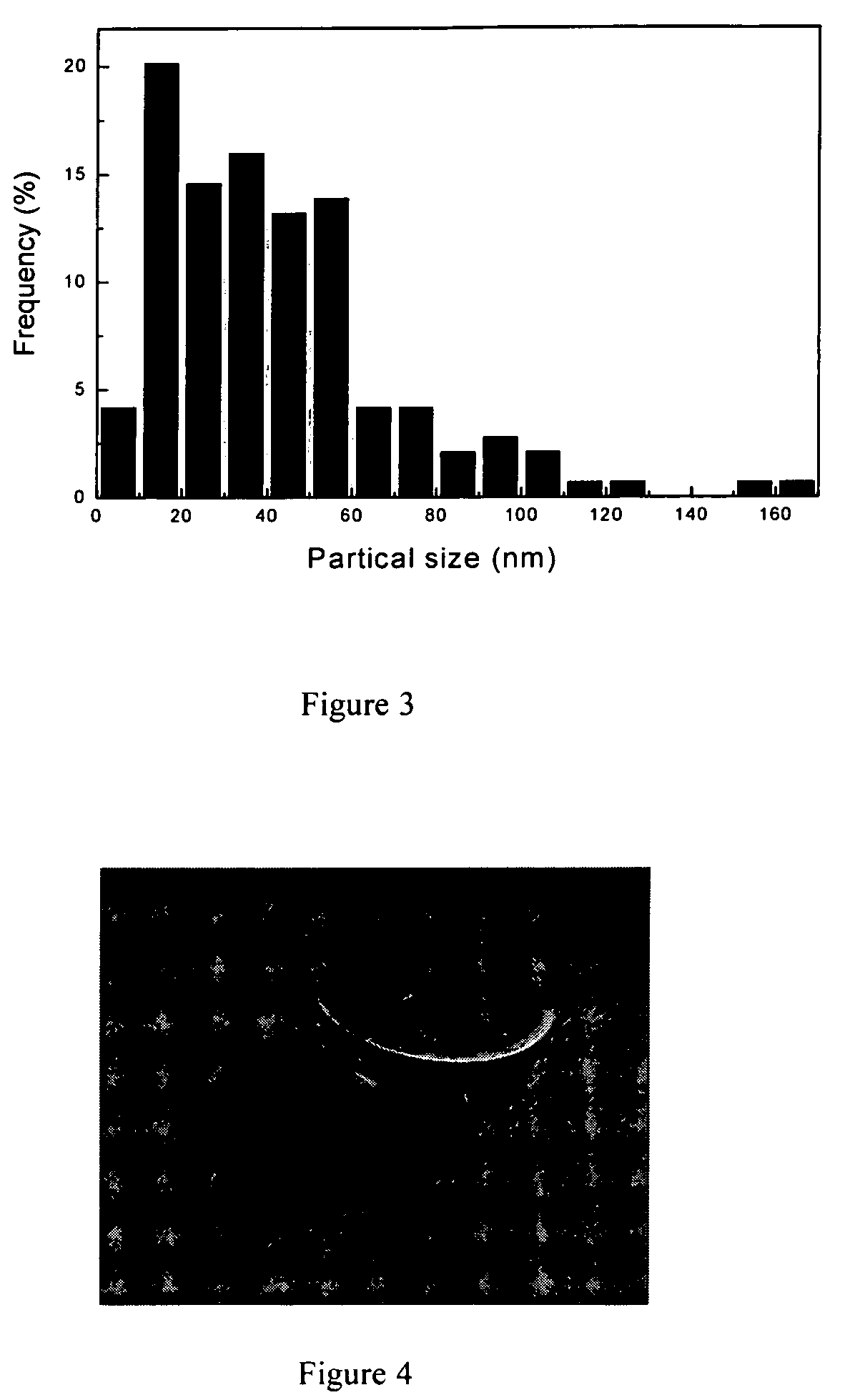Al2O3 dispersion-strengthened Ti2AlN composites and a method for producing the same
a technology of dispersions and ti2aln, which is applied in the field of ceramic composites, can solve the problems of difficult to produce bulk materials, difficult to eliminate the sample of the “413” phase, and relative difficulty in producing pure tisub>2/sub>aln, etc., and achieves good oxidation resistance, high strength, and high hardness.
- Summary
- Abstract
- Description
- Claims
- Application Information
AI Technical Summary
Benefits of technology
Problems solved by technology
Method used
Image
Examples
example 1
[0068]First, TiN nanopowders were prepared by HPMR continuously supplied with Ti rods. The chamber atmosphere is the mixture gas with a total pressure of 1 atm of N2, H2 and Ar, with 10% (by volume) N2, and the H2 to Ar ratio of 1:1 by volume. Al nanopowders were prepared by HPMR continuously supplied with Al rods. The chamber atmosphere is the mixture gas with a total pressure of 1 atm of H2 and Ar, with H2 and Ar ratio of 1:1 by volume. When Al rods were changed to Ti rods, Ti nanopowders were obtained by using the same process as that for Al nanopowders. The procedures of HPMR are: Samples were taken as anode, and tungsten electrode as cathode; when vacuum of the chamber reached to 3×10−3 Pa, Ar, H2 and N2 were charged at a given ratio; after a stable arc was established between the cathode and anode, the electrical current was stabled at about 200 A, and voltage was stabled at about 30 V; after every 0.5 h, N2 was supplied to keep the total pressure at about 1 atm; and after wor...
example 2
[0072]First, TiN nanopowders were prepared by HPMR continuously supplied with Ti rods. The chamber atmosphere is the mixture gas with a total pressure of 1 atm of N2, H2 and Ar, with 12% (by volume) N2, and the H2 to Ar ratio of 1:0.9 by volume. Al nanopowders were prepared by HPMR continuously supplied with Al rods. The chamber atmosphere is the mixture gas with a total pressure of 1 atm of H2 and Ar, with H2 and Ar ratio of 1:0.9 by volume. When Al rods were changed to Ti rods, Ti nanopowders were obtained by using the same process as that for Al nanopowders. After Ti and Al nanopowders were subjected to surface passivation treatments, oxygen content of Ti nanopowders and Al nanopowders is about 5% and about 8% by weight, respectively. The procedures of HPMR are: Samples were taken as anode, and tungsten electrode as cathode; when vacuum of the chamber reached to 3×10−3 Pa, Ar, H2 and N2 were charged at a given ratio; after a stable arc was established between the cathode and anod...
example 3
[0079]First, TiN nanopowders were prepared by HPMR continuously supplied with Ti rods. The chamber atmosphere is the mixture gas of N2, H2 and Ar, with a total pressure of 1 atm with 13% (by volume) N2, and H2 to Ar ratio of 1:0.8 by volume. Al nanopowders were prepared by HPMR continuously supplied with Al rods. The chamber atmosphere is the mixture gas of H2 and Ar with a total pressure of 1 atm, with H2 to Ar ratio of 1:0.8 by volume. When Al rods were changed to Ti rods, Ti nanopowders were obtained by using the same process as that for Al nanopowders. After Ti and Al nanopowders were subjected to surface passivation treatments, oxygen contents of Ti nanopowders and Al nanopowders are about 6% and about 10% by weight, respectively. The procedures of HPMR are: Samples were taken as anode, and tungsten electrode as cathode; when vacuum of the chamber reached to 3×10−3 Pa, Ar, H2 and N2 were charged at a given ratio; after a stable arc was established between the cathode and anode,...
PUM
| Property | Measurement | Unit |
|---|---|---|
| volume fraction | aaaaa | aaaaa |
| particle size | aaaaa | aaaaa |
| particle size | aaaaa | aaaaa |
Abstract
Description
Claims
Application Information
 Login to View More
Login to View More - R&D
- Intellectual Property
- Life Sciences
- Materials
- Tech Scout
- Unparalleled Data Quality
- Higher Quality Content
- 60% Fewer Hallucinations
Browse by: Latest US Patents, China's latest patents, Technical Efficacy Thesaurus, Application Domain, Technology Topic, Popular Technical Reports.
© 2025 PatSnap. All rights reserved.Legal|Privacy policy|Modern Slavery Act Transparency Statement|Sitemap|About US| Contact US: help@patsnap.com



